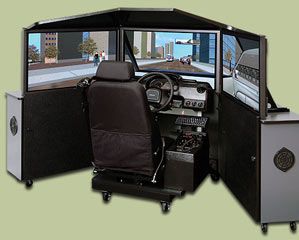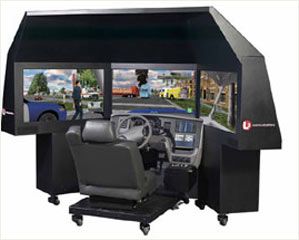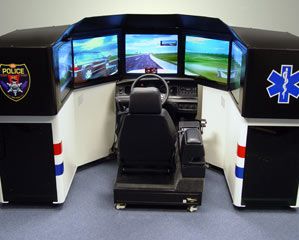Part 1: Driving Simulation: The Future is Now
with Capt. Travis Yates
Driving Simulation: Part 2
Once a law enforcement agency decides to use driving simulators to enhance their driver training program, funding is just the first obstacle. Research must be conducted — not only on the companies that manufacture simulators, but also on what features will be the most valuable for a given LE agency.
The three companies discussed below dominate the LE simulator market. While they’re all very similar, there are important distinctions.
THE COMPANIES
Doron Precision Systems, Inc.
 Doron 550LE |
Doron Precision Systems was founded in 1973, when it acquired the driver training system business from the Singer Company. Doron offers several variations of their simulators such as ambulances, transit, trucks and law enforcement. Today, Doron’s Simulators are spread throughout 60 countries. They have installed 143 LE-specific simulators in the last decade.
The 550LE is the latest LE driving simulator offered by Doron Systems. The 550 is a high resolution visual system with six real-time video channels. A unique feature within that system is digital voice instruction. Automated voice files provide detailed scenario instruction at the beginning of each exercise to each student.
The 550LE comes with a true-to-life, seamless “Virtual World” driving environment that, according to company literature, includes “urban, suburban, rural, industrial and interstate highways and training courses” that enables drivers to travel anywhere within the all encompassing VW 3.0™ without interruption.
Furthermore, Doron boasts exceptional customer service. The company maintains a full-time professional staff of factory-trained technicians, as well as a nationwide network of service personnel who provide on-site maintenance within 48 hours of notification, and offer an unlimited number of on-site calls. Doron is also the only manufacturer who provides preventative service calls.
Another major reasons to choose Doron’s 550LE, says Lawrence De Mayo, Doron Products; Contract manager, is that “the system has been designed to provide a platform for standardized training. Each trainee is presented with the same situations when driving a scenario"—of critical importance when an agency has to prove in court that each trainee received the same training.
MPRI
MPRI, an L-3 Communications company, offers simulators not only for LE, but also for the transportation industry, military, emergency medical responders, and commercial vehicles.
L-3 consists of 80 divisions and companies, and takes in over 12.4 billions dollars of revenue a year. The MPRI Simulation group is based in Salt Lake City, Utah and over 175 LE simulators are placed around the country.
 MPRI PatrolSim |
The PatrolSim IV is the latest LE driving simulator, and can be equipped with two interchangeable cores to provide lifelike simulations for both a police cruiser sedan and a fire truck. Each includes a seat, peddles, dash, brakes and steering wheel to provide trainees with the look and feel of their actual vehicles. The cores are easily swapped and quickly adapt to individual departmental training needs.
The realistic driving scenarios, displayed on three-channel plasma screens, train drivers to effectively anticipate and respond to hazardous driving conditions in a risk-free, controlled environment, improving decision-making and response time.
In instances of collision-avoidance or tire blows, the force-loaded steering provides real-time feedback to augment muscle memory. And the SimCommander allows instructors complete control of the training exercises via a touch screen at the Operators Console.
Each scenario can be individually recorded, which allows instructors and trainees to review, analyze and then learn proper techniques. In addition, physical responses while in the driver seat can also be recorded and assessed.
MPRI’s Replay Studio software uses a camera mounted on the simulator to film a student’s physical reactions that occur while driving. These movements are evaluated and reviewed as part of the overall assessment. This results in a reduction in accidents and a reinforcement of proper policy and procedure.
FAAC International, Inc.
FAAC’s roots began in the military more than 30 years ago as they began developing driving and flying simulators for all arms of the military. They were recently awarded a contract to build simulators for the Army’'s new Stryker vehicle and they have over 100 simulators located at Fort Leonard Wood (Missouri), the home of the United States Army Military Police School.
FAAC is located in Ann Arbor, Michigan and has simulators in four countries. FAAC joined the LE simulator ranks in 1999 when they partnered with California POST. Today, FAAC has approximately 30 LE simulators across the United States and their latest model is the Virtual Interactive Pursuit 5 (VIP-5).
 FAAC VIP-5 |
The VIP-5 is unique in that it provides a geometrically true, 225-degree horizontal field of view which requires the student to actually turn his/her head full left and right in order to clear intersections. This feature is provided by five plasma screens.
Terry Cutler, a FAAC law enforcement service/product manager and former Nevada deputy sheriff, says, “Other brands’ comparable models have three plasma screens. They look pretty and draw 190-degrees, but they’re not as realistic as the VIP-5 because you don’t have to look as far one way or the other.”
The dashboard of the VIP-5 is similarly true to life; its components are located as they are in a real vehicle, so drivers don’t have to keep fumbling around to orient themselves, and can instead concentrate on driving.
Additionally, the VIP-5 provides a natural, stable horizon/detached eyepoint (you see the hood of the car rise and fall, but the horizon stays steady).
“In motion simulation, you used to see the whole world moving up and down—this flattens suspension and terrain, which is a bad thing,” Cutler says. “Without the visual cues—seeing the transfer of gravity on the vehicle—the driver will end up accelerating too soon and will lose control and won’t know why.”
FAAC has a reputation for high reliability of components and customer service. “FAAC goes out of our way to please our customers and regularly delivers systems and services that far exceed specifications and expectations,” Cutler says, adding, “Our extended service contracts include on-site general maintenance visits.”
The Research
There are hundreds of features on each simulator. While each company markets a few unique characteristics to make them stand out from one another, the core systems are very much alike. Despite this, LE agencies must choose a particular manufacture with care.
No amount of research can replace the value of “seat time” in each simulator. Agencies should place several officers in each simulator, preferably at the same location where the simulators will be placed at the agency. With each simulator costing close to $100,000, companies should not hesitate to spend time with an agency in order to sell their product. If possible, simulator demonstrations between the different companies should take place as close as together as possible. This gives the officers evaluating an opportunity to compare each simulator with the most efficiency.
Several factors should be evaluated on the driving simulator. The most important is realism. Despite similar features, the simulators will feel different and the agency should strive for the most realistic environment possible. That may include a detailed evaluation of the graphics, feel of the steering / pedals, the interior look of the simulator and the overall dynamics of driving the simulator. In short, driving the simulator should feel more like driving a car than a video game.
Each company has a list of departments that have their particular simulator. While it is important to contact each of them about their experience with the particular simulator company, the agencies that have had the simulators the longest are the most important to call. These departments will have plenty so say, good or bad, about the system, customer service and whether they have noticed a difference in the driving behavior of their officers following simulator training. Not only should you speak to LE agencies about their simulator experience but it is just as important to speak with them about how they integrate it within their driver training program. A great simulator without a proper training program will be a waste of money and time for all involved.
The Location
The location of the simulators is an important topic to speak about with each company. There are typically two options: a classroom setting, or a self contained mobile classroom, such as a trailer. A state police agency or state academy may choose to place the simulators in a trailer and take them to the officers rather that the officer coming to the classroom. Each company has the capability to do that but there are additional costs involved. That cost is easily justified if more officers will be given the opportunity to utilize the training.
The Warranty
Each simulator will come with a limited warranty (usually one year) with the option to extend. The cost varies, but agencies should seriously consider adding years to the warranty because, while your present budget may allow for the purchase of the simulator, when it comes to funds, the future is never known. LE agencies should lock in an extended warranty with a possible software upgrade after a set number of years. The cost can be added to the simulator at the time of purchase and it will ensure that the agency will have a “working” simulator for some time in the future regardless of funding.
The Purchase
The funding of driving simulators will continue to be a challenge. While the systems are considered expensive, many departments have found subsequent litigation after collisions to be equally bothersome. Some agencies have located grants to purchase the equipment or charged a fee for outside entities in an effort to make up the cost of the purchase and maintenance.
Leasing is also a popular option. With the rapid advancement of technologies, departments can keep up with the latest innovations by paying a yearly lease.
Summary
Driving simulation has evolved into a viable option for LE agencies. As long as the decision to purchase is researched properly and all available information is sought, LE agencies will be pleased with the product they obtain and the subsequent training their officers receive.
For more information, please visit company web sites:
FAAC International, Inc.
L3 MPRI


